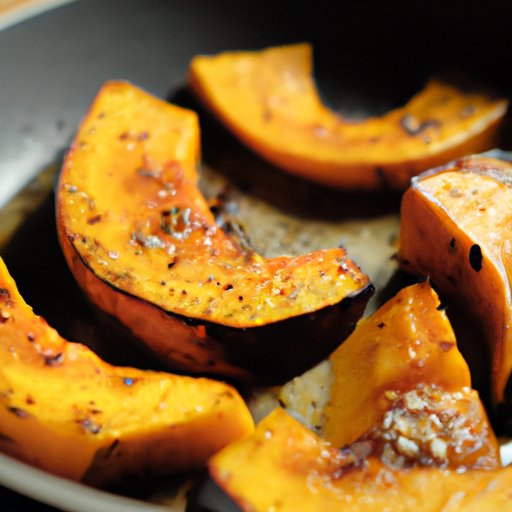I. Introduction
Welcome to the ultimate guide to roasting butternut squash! Whether you’re a seasoned pro in the kitchen or a beginner looking to try out a new recipe, roasting butternut squash is a healthy and delicious option that’s sure to satisfy a variety of tastes.
In this article, we’ll explore why selecting a good-quality squash is important, how to prepare it for roasting, and provide tips and instructions for seasoning it to perfection. We’ll also cover a quick and simple recipe, discuss the health benefits of roasted butternut squash, explore different variations and uses for it, and offer creative ideas for incorporating it into other dishes.
So, let’s get started!
II. Step-by-Step Guide
When it comes to roasting butternut squash, choosing a good-quality vegetable is key to achieving the best outcome. Here’s how to do it:
Selecting a Good-Quality Butternut Squash
When selecting a butternut squash, look for one that is firm and heavy for its size. Avoid squash that has soft spots, bruises, or blemishes, as these can indicate that it’s not as fresh. Also, the stem should be firmly attached and dry.
Preparing the Squash for Roasting
First, wash the squash under running water and pat it dry with a clean cloth. Then, use a sharp knife to cut off both ends of the squash. Stand the squash on one of its flat ends and carefully cut it in half lengthwise.
Next, scoop out the seeds and discard them or save them for roasting separately. You can use a spoon or an ice cream scoop to do this. Finally, peel the squash using a sharp vegetable peeler or a paring knife, being careful to remove all the skin.
Seasoning the Squash for Maximum Flavour
To enhance the flavour of the roasted squash, you can season it with different spices or herbs. Some popular options include cinnamon, nutmeg, garlic, rosemary, thyme, and sage. Drizzle with olive oil and sprinkle with salt and pepper to taste.
Roasting the Squash to Perfection
Preheat the oven to 375 degrees Fahrenheit. Place the prepared squash on a baking sheet lined with parchment paper or aluminum foil, cut-side down. Roast the squash for 35-40 minutes, or until it’s tender and golden brown. Use a fork or a toothpick to check the doneness.
III. Quick and Simple Recipe
If you’re looking for an easy and quick recipe for roasted butternut squash, try this one out:
Ingredients:
- 1 medium butternut squash, peeled and cubed
- 2 tablespoons olive oil
- 1/2 teaspoon salt
- 1/4 teaspoon black pepper
Instructions:
- Preheat the oven to 400 degrees Fahrenheit.
- In a large bowl, mix together the cubed squash, olive oil, salt, and black pepper, making sure that the squash is coated evenly.
- Spread the squash out in a single layer on a baking sheet lined with parchment paper or aluminum foil.
- Bake for 20-25 minutes, or until the squash is tender and golden brown, stirring occasionally.
IV. Health Benefits of Roasted Butternut Squash
Roasted butternut squash is not only delicious but also packed with nutrition. This vegetable is a good source of fiber, vitamin C, potassium, and antioxidants. Roasting the squash can also help to enhance its nutritional benefits by breaking down some of the fiber and other nutrients, making them more easily absorbed by the body.
V. Variations on Roasted Butternut Squash
One of the great things about roasting butternut squash is that you can get creative with how you season it and serve it. Here are a few ideas to get you started:
- Spiced: Sprinkle the squash with a mix of cinnamon, nutmeg, and ginger before roasting.
- Herbed: Use fresh herbs like sage, thyme, or rosemary to season the squash before roasting.
- Cheesy: Sprinkle the roasted squash with some grated cheese like Parmesan or Gruyere while it’s still hot.
- Nutty: Top the roasted squash with chopped nuts like pecans, walnuts, or almonds for some added crunch.
VI. How to Use Roasted Butternut Squash in Other Dishes
Roasted butternut squash is a versatile ingredient that can be used in a variety of dishes. Here are a few suggestions:
- Salads: Add cubes of roasted butternut squash to a green salad for a sweet and savoury twist.
- Soups: Puree roasted butternut squash with some broth, onions, and spices for a creamy soup.
- Pasta: Toss roasted butternut squash with cooked pasta and some parmesan cheese for a simple and satisfying meal.
Remember to store any leftover roasted butternut squash in the refrigerator in an airtight container for up to 5 days. Reheat it in the oven or microwave before using it in another dish.
VII. Conclusion
Roasting butternut squash is a simple and healthy way to add some variety to your meals. With its rich flavour and numerous nutritional benefits, roasted butternut squash is sure to become a staple in your cooking repertoire.
